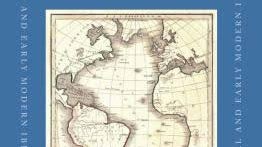This volume brings together an ensemble of multidisciplinary inquiries that argue for the integrated study of the Ibero-American Atlantic. In the past decade, this area of research and teaching has become more visible in the Anglophone academic milieu. Edited by Harald E. Braun and Lisa Vollendorf, Theorising the Ibero-American Atlantic covers a broad array of topics and includes approaches from various fields, ranging from historical analysis to literary surveys, and from social to cultural studies. Such a multidisciplinary profile makes this volume particularly attractive and original, though at times rather eclectic as far as its theoretical purpose is concerned.
In the opening pages of this collective volume, Braun and Vollendorf put forth the purposes of the book. Acknowledging that traditional scholarship too often separates Iberia from the Ibero-American lands, they advocate for the destruction of this theoretical scaffold. The editors of this volume remind us that Iberians established links and connections between previously disconnected peoples, and call for an approach capable of transcending national boundaries and concentrating on such interactions and points of connection throughout the whole of the Atlantic basin. This initial chapter also includes a review of the most significant scholarly work that has been done on the Ibero-Atlantic context. Though comprehensive, this overview could be substantially more detailed about the scholarship on the Ibero-American world developed in the past fifteen years, mostly by Brazilian and Portuguese historians. Luiz Felipe de Alencastro’s book about the 16th- and 17th-century Southern Atlantic (O Trato dos Viventes: Formação do Brasil no Atlântico Sul, 2000), for instance, deserved mention in these initial pages. The same applies to fundamental research on the Ibero-American Atlantic conducted by Brazilian and Portuguese historians, such as Nuno Gonçalo Monteiro, Maria Fernanda Bicalho, Maria de Fátima Gouvea, Júnia Furtado, João Fragoso, José Damião Rodrigues, Diogo Curto, Amélia Polónia, Mafalda Soares da Cunha, or Pedro Puntoni, to mention a few. This book could have been an excellent opportunity to make the Anglophone academic public more familiar with the works of these and other historians who publish mostly in Portuguese. Such an oversight haunts the remaining chapters.
Divided into three main sections, this volume begins by addressing the Ibero-American Atlantic world from a historical point of view. Bethencourt, Brookshaw, Moya, and Gould present a variety of perspectives on the historical background of that part of the globe, depicting a milieu in which circulation, interaction, and fluidity were constant from the sixteenth and seventeenth centuries onwards.
The second part of the volume is devoted primarily to cultural analysis, and includes an ensemble of essays that deal with transatlantic identities and ties. Focusing on a series of thinkers—women and men, Christians and Jews—all of them having in common the fact that they circulated between Iberia and the several parts of the Atlantic world, this section attempts to demonstrate the fluid and fruitful nature of scientific and literary production across that part of the globe. In her study about gender in the Iberian Atlantic diaspora, Vollendorf examines the role played by Iberian women sent to the Americas. Vollendorf correctly points out that gender and ethnic studies within the Ibero-Atlantic discipline offer fundamental pieces of the puzzle as Latin Americanists turn to Iberia as a means of understanding gender norms and ethnic communities in the Americas. The result is a deeper awareness of how gender codes operated in different times and places on more than a macro level. Graizbord’s contribution focuses on the ways through which the variable interplay of ethnicity, religion, racial constructs, and economic behavior challenged homogeneous conceptions of Jewish identity. Graizbord’s essay questions the essentialization of the concept of ‘Jewish Nation’ and argues for a more nuanced approach to Jewish and converso identity. Vanda Anastacio’s essay presents a series of eighteenth-century men of letters who circulated from one side of the Atlantic to the other, and demonstrates vividly the many intellectual and cultural bonds they established on both sides of the Atlantic.
The third part of the book focuses on migration and analyzes it from various points of view. This rather heterogeneous section covers an array of disparate topics: the role of Catalan migrants in the development of Uruguay (Harrington), the origins of Atlantic Modernism (Ginger), the politics of memory across the Atlantic (Martin-Cabrera), and the situation of Latin American women working in contemporary Iberia (Flesler and Shepherd).
Some of the more stimulating and original contributions to this volume are provided by its initial and closing essays. In rather provocative fashion, Jorge Cañizares-Esguerra’s foreword challenges the theoretical assumptions behind this volume. He rightly argues that it might not be relevant to classify the various ‘Atlantics’ based on national criteria, as if homogeneous cultural zones existed in that part of the globe. According to Cañizares-Esguerra, to do so one runs the risk of producing oversimplifications grounded in national differences. Cañizares-Esguerra also disputes the traditional idea that the British Atlantic was less racially integrated than the Spanish Atlantic because of cultural and religious differences between the two national groups. “All Atlantics are hybrid, the product of multiple ‘entangled histories’”, Cañizares argues (p. ix), and he eventually concludes that the British or French Atlantic could be just as hybrid as the Iberian one, all depending on demography, context, and contingency.
In the closing essay of this volume, Joan Ramon Resina presents a reflection about the current state of Hispanism in the Anglophone academic milieu. As is well known, Resina is an enthusiast of the concept of ‘Iberian studies’. According to him, such a field constitutes “a compromise between the geographically contiguous and the historically entwined without sacrificing cultural diversity” (pp. 268–269). This endorsement allows him to call attention to the importance of not reducing Spanish to Castilian culture. He also warns of the risks of conceiving the studies of the Iberian Peninsula in terms of two politically separated states, each one with its own national history and culture. The concept of ‘Iberian studies’, according to Resina, has the advantage of integrating, relating, and relativizing. Nonetheless, and in spite of his optimism, Resina acknowledges that “. . . this requirement of mastering hitherto flouted traditions meets with the hostility of traditional Hispanists who find it easier to promote the myth of a unified national culture than to acquire the supplementary skills” required for scholarship (p. 269).
Though a clear endorsement of the idea of ‘Ibero-American Atlantic studies’ as a fruitful framework both for research and university training, this collective volume also addresses the limits of such an analytical tool. Most of the contributors agree on the fundamental importance of encompassing Ibero-American complexity. However, some also acknowledge that the Ibero-Atlantic cannot be conceived of as a self-enclosed unit. Additionally, they also warn that the emphasis on exchanges must not result in the scholarly exclusion of peoples, cultures, or artifacts that did not travel along transatlantic routes. In order to avoid this, it is, for instance, necessary to consider ‘European’ Iberia in its full complexity, taking into account not just the Castilians or the Portuguese, but also the Catalans, the Basques, the Galicians, the Valencians, the Andalusians, the Mallorcans, and, last but not least, the Canarians. The same applies to the variety of peoples living in all margins of the Atlantic. The real challenge is to account for all the specificities of these groups while simultaneously avoiding treatment of them as homogeneous collective units. Hybridism and mixed communities were, and still are, predominant.
In what is absent from the volume, we can also see the necessity of overcoming certain deficits in the knowledge of the Ibero-American Atlantic. For instance, it is indispensable to take into account, in a more systematic way, the relation of Portugal to Spanish-speaking America; the same applies to that of Brazil with Spain’s varied cultural traditions. Parallel to the traditional comparison between Spain and Portugal, a more transversal and plural approach awaits development. The book is more successful in its demonstration of the need to put women—of European, American, African, and Asian descent—in a more central position on the research agenda. As for the presence of Africa and African agency in this field of study, it must indeed be strengthened, and the same can be said about the Native peoples of America. Africans and Amerindians both endured, and contributed to, the formation of the Ibero-American Atlantic. They were successively decimated by war, epidemics, and displacement, but also negotiated their position and asserted themselves as players within colonial societies. While doing so, they built new forms of identity and managed to play an active role in the formation and evolution of various colonial contexts. On a related front, the Portuguese participation in the slave trade between Africa and the Americas, though it was “the engine of what is today called ‘the Lusophone world’” (Brookshaw, p. 38), continues to be an almost taboo topic for many Portuguese scholars. It is, in fact, barely studied in Portugal.
One final remark about the thorny question of modernity, or, more precisely, the place of Iberian peoples and spaces in the big narrative of scientific development and modernization: underlying this and other recent contributions is the assumption that the Ibero-American Atlantic is an overlooked cultural player in many dominant versions of cultural and intellectual history. The volume thus calls attention to the Iberian and Ibero-American contribution to the political, economic, social, and cultural development of the Atlantic world.
On the whole, it can be said that Theorising the Ibero-American Atlantic shows that the connection between the two main Iberian polities and the Atlantic world involved both elites and ordinary people. This fact becomes particularly visible in the many pages this book devotes to migration, in which one sees that the Iberian Atlantic was also forged from below by millions of anonymous migrants, many of them transcending the political boundaries of the Iberian world. The geography of the Ibero-American Atlantic is therefore also a matter of debate, and the same can be said about its chronological boundaries. José Moya, in one of the most stimulating contributions to this volume, questions the chronological limit of 1800 and argues convincingly that after that date, the Atlantic basin continued to be an intertwined space. As is clearly demonstrated by several of the contributors to this book, the post-independence Iberian and Ibero-American world had more continuities with its past than is usually thought.
Reviewed by Pedro Cardim
Universidade Nova de Lisboa
Pedro Cardim is Associate Professor of early-modern history at the Universidade Nova de Lisboa (UNL), and currently holds the Chair in Spanish Culture and Civilization, King Juan Carlos I of Spain Center, New York University. He is the author of various studies on Portugal and its relations with the Iberian world during the early-modern period. He has organized several international meetings on the history of the Iberian monarchies. He is a member of the board of CHAM – Portuguese Centre for Global History (UNL), and is Principal Investigator of a research project (funded by Marie Curie Actions) about the place of Salvador da Bahia in the early-modern and modern Ibero-American Atlantic.
InterDISCIPLINARY
Journal of Portuguese Diaspora Studies . Vol. 3.1
(2014):281-84.




